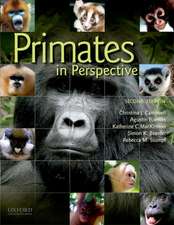Primate Conservation Biology
Autor Guy Cowlishaw, Robin I. M. Dunbaren Limba Engleză Paperback – 10 oct 2000
From the snub-nosed monkeys of China to the mountain gorillas of central Africa, our closest nonhuman relatives are in critical danger worldwide. A recent report, for example, warns that nearly 20 percent of the world's primates may go extinct within the next ten or twenty years. In this book Guy Cowlishaw and Robin Dunbar integrate cutting-edge theoretical advances with practical management priorities to give scientists and policymakers the tools they need to help keep these species from disappearing forever.
Primate Conservation Biology begins with detailed overviews of the diversity, life history, ecology, and behavior of primates and the ways these factors influence primate abundance and distribution. Cowlishaw and Dunbar then discuss the factors that put primates at the greatest risk of extinction, especially habitat disturbance and hunting. The remaining chapters present a comprehensive review of conservation strategies and management practices, highlighting the key issues that must be addressed to protect primates for the future.
Primate Conservation Biology begins with detailed overviews of the diversity, life history, ecology, and behavior of primates and the ways these factors influence primate abundance and distribution. Cowlishaw and Dunbar then discuss the factors that put primates at the greatest risk of extinction, especially habitat disturbance and hunting. The remaining chapters present a comprehensive review of conservation strategies and management practices, highlighting the key issues that must be addressed to protect primates for the future.
Preț: 301.71 lei
Nou
Puncte Express: 453
Preț estimativ în valută:
57.73€ • 60.28$ • 47.78£
57.73€ • 60.28$ • 47.78£
Carte tipărită la comandă
Livrare economică 04-18 aprilie
Preluare comenzi: 021 569.72.76
Specificații
ISBN-13: 9780226116372
ISBN-10: 0226116379
Pagini: 498
Ilustrații: 89 line drawings, 59 tables
Dimensiuni: 152 x 229 x 33 mm
Greutate: 0.68 kg
Ediția:1
Editura: University of Chicago Press
Colecția University of Chicago Press
Locul publicării:United States
ISBN-10: 0226116379
Pagini: 498
Ilustrații: 89 line drawings, 59 tables
Dimensiuni: 152 x 229 x 33 mm
Greutate: 0.68 kg
Ediția:1
Editura: University of Chicago Press
Colecția University of Chicago Press
Locul publicării:United States
Notă biografică
Guy Cowlishaw is a research fellow at the Institute of Zoology, Zoological Society of London.
Robin Dunbar is a professor of biological sciences at the University of Liverpool.
Robin Dunbar is a professor of biological sciences at the University of Liverpool.
Cuprins
Acknowledgments
1. Introduction
2. Diversity
2.1. The Primate Order
2.2. Patterns of Diversity
2.3. Origins of Diversity
2.4. Summary
3. Behavioral Ecology
3.1. Life History
3.2. Ecology
3.3. Behavior
3.4. Summary
4. Community Ecology
4.1. Community Species Richness
4.2. Community Structure
4.3. Competition in Communities
4.4. Primates in Plant Communities
4.5. Summary
5. Distribution, Abundance, and Rarity
5.1. Geographic Distribution
5.2. Population Abundance
5.3. Distribution-Abundance Relationships
5.4. Summary
6. Population Biology
6.1. Demographic Variables
6.2. Population Dynamics
6.3. Metapopulation Dynamics
6.4. Population Genetics
6.5. Summary
7. Extinction Processes
7.1. Extinction Rates
7.2. Causes of Extinction
7.3. Species Differences in Extinction Risk
7.4. Case Studies in Primate Extinctions
7.5. Summary
8. Habitat Disturbance
8.1. Patterns of Habitat Disturbance
8.2. Effects of Habitat Loss
8.3. Effects of Habitat Fragmentation
8.4. Effects of Habitat Modification
8.5. Species Vulnerability Patterns
8.6. Summary
9. Hunting
9.1. Optimal Foraging Theory
9.2. Hunting Patterns
9.3. Trade in Primates
9.4. Effects of Hunting
9.5. Species Vulnerability Patterns
9.6. Hunting with Habitat Disturbance
9.7. Summary
10. Conservation Strategies
10.1. Strategy Design Principles
10.2. Setting Taxon Priorities
10.3. Setting Area Priorities
10.4. Practical Considerations
10.5. Summary
11. Conservation Tactics
11.1. Protected Area Systems
11.2. Sustainable Utilization
11.3. Captive Breeding
11.4. Restocking and Reintroduction
11.5. Summary
12. Conclusions
12.1. The Past and Future of Primate Diversity
12.2. Diagnosing Populations in Trouble
12.3. Effective Conservation Action
12.4. Finding Unique Solutions
Appendix 1. Primate Species and Conservation Status
Appendix 2. Leslie Matrices
Appendix 3. Primate and Conservation Organizations
References
Index
1. Introduction
2. Diversity
2.1. The Primate Order
2.2. Patterns of Diversity
2.3. Origins of Diversity
2.4. Summary
3. Behavioral Ecology
3.1. Life History
3.2. Ecology
3.3. Behavior
3.4. Summary
4. Community Ecology
4.1. Community Species Richness
4.2. Community Structure
4.3. Competition in Communities
4.4. Primates in Plant Communities
4.5. Summary
5. Distribution, Abundance, and Rarity
5.1. Geographic Distribution
5.2. Population Abundance
5.3. Distribution-Abundance Relationships
5.4. Summary
6. Population Biology
6.1. Demographic Variables
6.2. Population Dynamics
6.3. Metapopulation Dynamics
6.4. Population Genetics
6.5. Summary
7. Extinction Processes
7.1. Extinction Rates
7.2. Causes of Extinction
7.3. Species Differences in Extinction Risk
7.4. Case Studies in Primate Extinctions
7.5. Summary
8. Habitat Disturbance
8.1. Patterns of Habitat Disturbance
8.2. Effects of Habitat Loss
8.3. Effects of Habitat Fragmentation
8.4. Effects of Habitat Modification
8.5. Species Vulnerability Patterns
8.6. Summary
9. Hunting
9.1. Optimal Foraging Theory
9.2. Hunting Patterns
9.3. Trade in Primates
9.4. Effects of Hunting
9.5. Species Vulnerability Patterns
9.6. Hunting with Habitat Disturbance
9.7. Summary
10. Conservation Strategies
10.1. Strategy Design Principles
10.2. Setting Taxon Priorities
10.3. Setting Area Priorities
10.4. Practical Considerations
10.5. Summary
11. Conservation Tactics
11.1. Protected Area Systems
11.2. Sustainable Utilization
11.3. Captive Breeding
11.4. Restocking and Reintroduction
11.5. Summary
12. Conclusions
12.1. The Past and Future of Primate Diversity
12.2. Diagnosing Populations in Trouble
12.3. Effective Conservation Action
12.4. Finding Unique Solutions
Appendix 1. Primate Species and Conservation Status
Appendix 2. Leslie Matrices
Appendix 3. Primate and Conservation Organizations
References
Index












